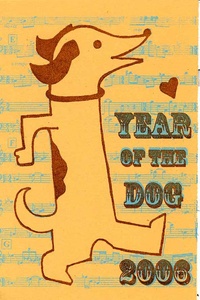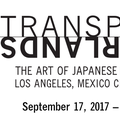Susan S. has an annual tradition that she’s followed for over thirty-six years, animal by animal. Having been lucky enough to have spent the past twenty years as an archivist at a world-class library where she gets to roam its stacks, attics, and moats at will, she is a great lover of ephemera and the collectable memorabilia of our past.
An accomplished author of many beautiful books, Susan also practices an art known to few in this country, a habit she picked up after living in Japan for several decades. Her art is parsed in extremely limited editions and made public only once a year through the US postal system. January 1, 2012 hails the beginning of the Year of the Dragon. Without fail, Susan has once again taken her carving tools to the task and interpreted the dragon in a hand-printed linoleum block nengajo with her unique combination of piquancy and zest.
Nengajo (also known as nenga hagaki) are postcards sent as New Year greetings on the first of the year. A special mailing system through Japan Post, which enables postcards that have been sent by mid-December to all arrive at once on January 1st, was purportedly started well over 100 years ago. Today, more than 4.1 billion nengajo are printed and mailed in the month of January.
While commercial nengajo to email or send by phone are increasingly on the rise, the truly unique, paper nengajo offer an opportunity for one’s inner creative to emerge once a year. Of course, pre-printed cards can still be purchased at stationery or department stores and customized nengajo software for printing on a home computer are always a hefty part of every year’s nengajo haul, but it is the hand-crafted nengajo that I seek.
Nine times out of ten, New Year postcards rely on the present year’s zodiac animal as the primary design, following the Chinese zodiac cycle (for the record, the animals are, in order: rat, ox, tiger, rabbit, dragon, snake, horse, sheep, monkey, rooster, dog, and boar. And yes, the rat is always the first animal in the race around the twelve-year calendar).
The original purpose of nengajo was to report tidings to faraway friends and relatives. In other words, this custom existed for people to tell others that they were still alive and allowed them to express hopes that the year ahead would be even luckier, richer, healthier, and all around better than the last.
In the nineties, I spent several years living in Japan, which is how I first encountered the nengajo tradition, and was instantly smitten. As it happened, I was living with a traditional washi papermaker in the remote green mountains of Warabi, Gifu-prefecture, a place where paper wasn’t simply a product of industry. For six months, I practiced the process of traditional papermaking, boiling young branches of mulberry in ash and lye, scraping tough knots where the node met the branch and any remnants of red bark from individual strands under a trickle of icy water, pounding and scooping the white fibers shot with gold onto bamboo trays. It was not mere learning, it was sheer worship. I also gained a profound understanding of paper’s purpose: light reflects magically upon the pristine white sheets and with the application of the alphabet or numericals with black ink, history could be recorded and news of one’s well being could now be sent to far-off places.
My papermaking teacher was a gregarious fellow with hundreds of individuals to send his best wishes for prosperity, fortune, and good health to, which meant his nengajo production was SERIOUS BUSINESS. Earlier in the year, he had introduced me to linoleum block printing, keeping a giant, economical roll of it in his studio in case he was ever struck with a desire to carve and print on the crisp sheafs of paper we stored throughout the wooden house all the way up to its rafters. But on this occasion and much to my surprise, my mentor reached into the closet for a totally new-fangled contraption that he explained was his nengajo machine. The machine was fashioned out of a powdery blue plastic, came with some rather ill-smelling flashbulbs, and required AA batteries.
What I didn’t realize at the time was that I was staring at a Gocco, a fantastically clever screen-printing toy that was created in Japan specifically for the nengajo market, which explains to frustrated Gocco fanatics around the globe why the majority of its models fits 4" x 6" images, maximum. Gocco was developed in 1977 using flash bulbs, a carbon-based image and an emulsion-coated screen, allowing the user to stamp out hundreds of customized, personal prints and for nearly two decades, sales of the machines soared in Japan. It was the Year of the Ox, and as the papermaker’s apprentice, I got the job of gocco’ing bulls kicking up their heels under the moon on an endless stack of blank postcards.
By the time I came back to California and mustered up the courage to make my own nengajo debut, it was the Year of the Snake. Using my own pet snake as my model, I went back to the papermaker’s first printmaking lesson, and carved the image out of linoleum and printed the postcards using a tabletop platen press. The following year, I neglected to fire on all cylinders and skipped the Year of the Horse, but picked up the nengajo tradition again in the Year of the Ram. And so the nengajo custom began, although noone else in my family had ever heard of, let alone made or sent nengajo in California before. A purposeful visit to specialty stationery stores such as Kinokuniya might yield packaged pre-printed nengajo, but for the rest of us, we have to make our cards by hand.
Presumably, everyone just thought of me as being animal fixated, and indeed for a few years I collaborated with a sansei artist to produce zodiac animal calendars in addition to the annual nengajo print fest. Susan’s nengajo artwork came to my attention when she sent one to the publishing company where I worked at, knocking me out with her illustration and design finesse, while delighting me with the simple fact that she observed this arcane and remote tradition. Looking ahead I see that next year is the Year of the Snake, which brings me at last, to my first full zodiac cycle. I still have a long way to catch up to her; she’s been around the zodiac block three times. Sigh.
In a marathon gocco printing on New Year’s Eve with assistance by my husband, the 2012 dragons have been laid out, huffing smoke. As I finished penning the last of this year’s greetings and fixing postcard stamps on each of them, it suddenly occurred to me (consistent to my overall weakness for rare and endangered cultural species such as books and museums) my nengajo habit is entirely reliant on the US postal service, which has begun voicing throes of an elegy. For what joy is left in sending a group spam affixed with glittering gifs when I can still sketch, transfer, carve, and print my nengajo by hand, its ink and paper poetically tactile?
© 2012 Patricia Wakida










